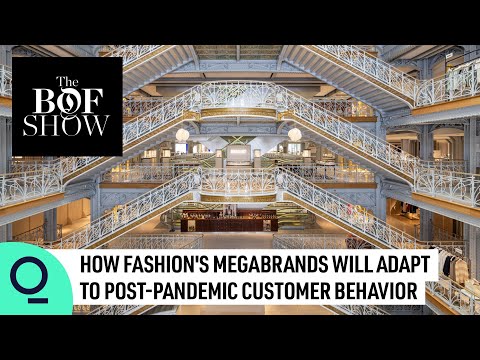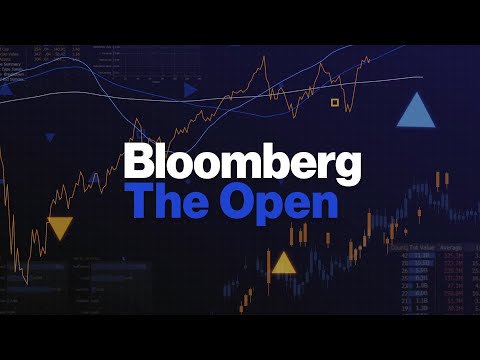How Fashion's Megabrands Will Adapt to Post-Pandemic Consumers | The Business of Fashion Show

The luxury industry is reinventing the way it connects with customers in a landscape forever altered by the pandemic. So, here we are in Paris, and one of the things I absolutely wanted to do was to understand how all of the time that people have spent at home has changed the way they shop in stores, and there's kind of no better place to do that than here at La Samaritaine. Hello! Hello, Imran. So nice to meet you, are we doing this? Welcome, welcome here, you know, to Samaritaine. Oh, it's amazing. At the time of its reopening, following a $1 billion restoration, Parisians are keen to take a look around, but luxury tourists are nowhere to be found. So, for now, the all-important Chinese luxury customers are getting used to shopping at home.
Chinese consumers have now come around to accepting the prices in China. That psychological barrier is already overcome. Top luxury executives are still bullish because this is an industry with built-in growth. The share of the young generations in the total business is increasing, so there is a very strong and, I think, structural rebalancing between people from 40 years old and above and people from 40 years and below.
And this is driving exceptional expansion for the biggest luxury brands, whose businesses have already surpassed pre-pandemic levels. But how are luxury executives preparing themselves as the world reopens? We have more and more customers, so our customers are going everywhere. Past year, double digits in every single country, so we have more and more customers. What we wear says a lot about who we are.
I'm Imran Amed, and this is The Business of Fashion Show. I'm on a journey to see how fashion is recalibrating amid the pandemic to balance profit with purpose. Join me to discover how fashion shapes business, culture, and identity, and to meet the people forging fashion's future. This is La Samaritaine, where the boast used to be, "On trouve tout à la Samaritaine," the place where you can find everything. The iconic Parisian department store was founded in 1870, but closed in 2005 due to health and safety concerns only four years after LVMH, the world's largest luxury group, bought a controlling stake.
LVMH spent years refurbishing its Art Nouveau and Art Deco architecture, but delays plagued the construction, and when La Samaritaine was finally ready in April, 2020, the pandemic stopped everything. Now, La Samaritaine has finally reopened, and I am excited to explore. Shall we take a look around quickly? Yes, absolutely. All right, amazing. My tour guide is Eleonore De Boysson, President for Europe, the Middle East and Africa of DFS, the luxury travel retailer. It was her mission to bring new life back to this old Parisian landmark. I want to learn how her plans have changed.
How do you think this is different? You know, Paris has no shortage of department stores, right? In the LVMH group, you have Le Bon Marché. There's also Printemps, there's Galeries Lafayette. Yeah, yeah. When you have so much competition, how do you create something different? The first thing is, you know, we really created a living place, not just a place for shopping, and it's a combination, if you want, of different things.
I mean, first you have, you know, all they offer, which is not only the big international brands, but this, you know, multiplicity of smaller brands that are really surprises for Parisians or for tourists, and so on. I asked Eleonore how she was planning for the current situation, where the tourists, expected to drive 50% of foot traffic and an even higher percentage of spend, are missing. I really believe that if we do something which is suited for the Parisians, if they really like the store and come back often because we give them reasons to come back, because the store is changing, you know, all the time and will evolve permanently, I believe that's where tourists want to go because they want to go in an authentic place when they come back. You know, with all of that spending not happening here, you know, how do you adapt to this situation, because obviously you had the budgets and plans for, like, all these Chinese tourists. Obviously, I mean, obviously, you know, it will be a couple of years, you know, before the tourists come back.
I mean, maybe in a year, a year and a half, you know, a little bit more difficult, but it doesn't really matter because we are really thinking, you know, in the long-term. So, you know, whether we are here for decades. To understand how luxury fashion brands are adapting, we must first understand how the luxury customer base is changing. Who drives luxury spending now? The Chinese, to the tune of $130 billion a year.
That's more than 35% of the global total. Who are the decision-makers of the future? The under 25 global demographic known as Gen Z. Around the world and in real life, and certainly on TikTok, Gen Z are hyper-connected, niche-influenced and socially informed.
Overlay these two groups and you get what China calls its post-1995 and post-2000 generations. For luxury brands, that's a valuable Venn diagram. Luxury sales in China grew by 45% in 2020, where the under 25s spent five times more than their peers in the US.
When you take into account the influence they have over family spending, that figure rises further. 40% of young, single Chinese living in Tier-1 cities call themselves the Moonlight Clan because they tend to spend their entire monthly salary over a single lunar cycle, but with international travel curtailed, reaching the Chinese on home turf is vital. Mega brands are harmonizing global prices and going all out to spark engagement. Now, competition comes from chic homegrown labels. After three decades of aspiration for European brands, more than a quarter say they prefer made in China to made in France.
To win Gen Z's hearts and wallets, brands must wear their values on their sleeves. To better understand the impact of the pandemic on luxury customers in China, I caught up with one of the most influential figures in the global fashion industry. For the first time in more than a decade, Angelica Cheung is missing Haute Couture Week in Paris, which happens twice a year, in January and July. Hi, Angelica. Hi, Imran.
Good to see you again. I know. We've managed to keep in touch quite a lot over the last 12 months, but only virtually because you've been in China the whole time. Well, yes, you know, it's unbelievable. The former editor-in-chief of Vogue China also has a new job. In February, 2021, she announced that she was crossing over to join the venture capitalists. Sequoia Capital China recently invested in Montreal-based SSENSE, a luxury e-commerce company targeted at Gen Z and now valued at $4.1 billion.
Angelica was named to the board to advise on engaging with the key demographic driving luxury growth, Chinese youth. At some point, Angelica, China will open its borders and people will be able to travel again. What behaviors of this Chinese luxury customer are going to stick? I think that what's changed about Chinese consumers is that they are so much online now, so digital, so much into e-commerce, you know, getting everything, and also, you know, don't forget that Chinese consumers have now come around to accepting the prices in China. That psychological barrier is already overcome.
What do you think are the biggest changes in the way the Chinese customers' mindset and, you know, attitude is towards this industry? Like, you said they've become more sophisticated. Well, I think, for one, the obvious change is the shift from logo to no logo, and now the new generation, logo again, but in a very different way, you know. Earlier, 15 years ago, the logo was really for very few people who became more successful or affluent. They were really symbols of status at that time. Yeah. And then fast forward, the new logo period is really the Gen Z, the Millennials generation.
The interlocking Cs of Chanel, one of the most recognizable brands in the world which generates more than $10 billion in annual revenue. Chanel is owned by the elusive Wertheimer family that avoids press attention. Luckily, they have an affable president, in the form of Bruno Pavlovsky, who runs the global fashion business. Under his leadership, Chanel is holding fast to physical boutiques and live fashion shows as a way of connecting with customers. I wanted to learn why. At Chanel, we have our way of doing it, and it's not only because it's a crisis.
I think that the show, the fashion show, is the beginning of the storytelling. We are engaging a lot of customers through these shows. We have thousands and thousands of people who are engaging with the brand through this new storytelling.
It's too far, where fashion is available in the boutiques. That's a way to connect with the creative part, with Virginie [Viard], to understand the next step of the brand. Also, a way to create a famous dream through our collection, and the best way to communicate, to engage, with these fashion shows. The late Karl Lagerfeld's Chanel shows grew to a scale unseen before in fashion. Ambitious, innovative, and playful. From the 1950s through to today, the signature Boucle Jacket is ever-present and re-imagined for the moment.
Chanel's shows, once reserved for industry insiders, are increasingly designed to engage customers following online. In 2020, a new creative director, Virginie Viard, continued to stage fashion shows, even if it was not possible to have a physical audience. Chanel is also sticking to its guns when it comes to physical retail. You and I have talked in the past a lot about Chanel's position, which is, you know, we don't sell clothing or ready-to-wear or handbags on the internet.
Did, at any moment during the pandemic, you regret that decision because other brands saw a massive spike in sales? No, because when we know customers and when she needed something special, we can organize that, but it's not through chanel.com or e-commerce, it's through the relationship, and it's working, you know? Perhaps if it was not working, we'll have asked the question ourself, is that right way of doing things? But we don't try to sell more handbags, we don't try to sell more Chanel. It's about this new experience that we try to offer to the customers, and we want them to see and touch. I know that, quite often, they know exactly what they want, but you know, what we noticed is that when they come to the boutique and think, I want that, they quite often go out with something else. So, the fact, to be able to come in the boutique, to discover the collection, to see perhaps more than what you imagined is always good. So, Chanel is about your dream, and we like to keep the surprise.
Do you think you might be missing out on some new customers? Maybe, but we have more and more customers. So, I understand the point, is that our customers are going everywhere. Past year, double digits in every single country. So, I think that what you mention is rare.
It's a risk, obviously, but at the same time, we are seen more and more successful. Thank you, Bruno. Thank you. It was very nice to talk to you.
Thanks. All right. So, it's not that Chanel is rejecting digital innovation. It's just choosing how and where to embrace it. For another perspective, I head across town to le septième, Paris' 7th arrondissement.
The global headquarters of Kering are not what you might expect, housed in a former hospital constructed beginning in 1692. So, we are at the global headquarters of Kering, which is the luxury group that owns a number of internationally renowned fashion brands, including Gucci, Saint Laurent, Balenciaga, Alexander McQueen, Bottega Veneta, and a number of other big luxury brands. François-Henri Pinault leads Kering, the world's second largest luxury group, which made more than $17 billion in annual sales before the pandemic. The jewel in the Kering crown is Gucci, which generates more than 80% of operating income. Amid the global health crisis, revenues at Kering dropped 17.5% in 2020. 12 months later, customers in Asia and the US are driving a sharp recovery.
During the first half of 2021, e-commerce revenue at Kering was up 78.5%. The behaviors luxury customers learned during the pandemic are sticking. I wanted to start with the last 16 months.
It feels like the fashion world is kind of snapping back to its old ways of operating, you know, that there's a reawakening happening. Everyone's, you know, people are back from all over the world. Is this over? No, it's not. No, it's not, we need to be very cautious because a year ago, we thought it was over and it came back. So, we don't know, and no one knows. Yeah. I'm keen to understand who you see as the luxury customer now.
How do you think about that customer? How do you describe that customer? What is structural in terms of the new world of luxury is that the share of the young generations in the total business is increasing, so there is a very strong and, I think, structural rebalancing between people from 40 years old and above and people from 40 years and below. It used to be three quarters of the older generation and one quarter of the younger generation. It's more 50/50, and even 60/40, and I do really believe that they expect from brands, and particularly from luxury brands, very different things than the previous generations in terms of commitment, in terms of sense of purpose. Now, it's not just about beautiful product, it's much more than that. They want to make sure that the way those products are conceived, built, are respectful. How do you see that luxury customer having been impacted by the pandemic? You know, the Chinese customer, for example, if you go around the stores here in Paris, at this time of year, normally, the city would be packed with tourists.
It shows us something very important, is that this business of luxury is about human connection. And even though the crisis has shown that you need to be accessible because people want to continue to have the dialogue with you, even if it has to be done through websites, internet, at a distance, it doesn't mean that this is satisfactory. It's better than not being in touch with your customers, so that's why it's working, but we still need to find ways of reconnecting with people, even at a distance. Interestingly enough, last year, in '19, we were every agreement while doing e-commerce was around 6%, your direct e-commerce business, and then it doubled or it tripled in a year, but what appeared is what we call distant sales from stores, which is a sales associate, human people, Talking at a distance with customers, being a video, or it could be a chat. And this is why it's not obvious, but for me, it showed us that, how important is, and will be, the human connection in this business.
Even though you are very strong and we are very strong online in all the brands, we cannot leave it like this. How do we recreate this human bond, even online? Thank you, Mr. Pinault. Thank you. Kering has shown how technology can drive customer interactions and impressive sales growth, but by the time the tourists come back to Europe, they'll be looking for something different.
Chinese luxury consumers have become more sophisticated. More and more, they are into seeking exclusive products, limited editions, you know, things that they don't see on everybody. So, when they start to travel one day overseas, hopefully soon, we all hope, that I feel they expect to see different products, you know, when they go everywhere else. You know, why they go to the same brand shop, you know, in Paris, in Milan, in London, when they actually have everything here, that's something that probably is going to happen. Angelica, thank you so much for connecting with me all the way from Beijing. Yes, my pleasure. Yes, next time we chat, we'll do it face to face.
For luxury, this is an era of reinvention. The pandemic may not be over, but it has already underscored to luxury executives the importance of creating human connections with their customers, and now they have more ways than ever to do so.
2021-10-16 05:53


